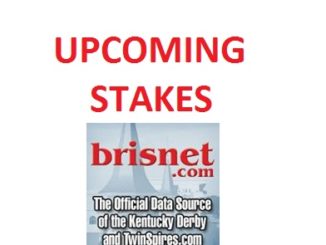
by SCOTT SHAPIRO
 Thursday, March 2, marks the start of my new role with Brisnet.com as its Southern California handicapper.
Thursday, March 2, marks the start of my new role with Brisnet.com as its Southern California handicapper.
Not only will I be providing a preview and a recap article each week, but also my selections for every race at Santa Anita Park, Del Mar, and Los Alamitos will be available as part of Brisnet.com’s Daily Selections full-card analysis with best bets.
Since many of you will be counting on my handicapping research and experience to help you with Southern California racing, I wanted to share a bit about my general approach to analyzing a race before we get rolling on Thursday at Santa Anita.
My handicapping approach, like most, is multi-faceted—incorporating data, analytics, and personal observations.
When I dive into a card for the first time, I am watching a lot of race replays, comparing my thoughts with my notes from that day of racing, and then using my opinions along with commercial data (e.g. PPs, performance figures, etc.) to try to visualize the race in my head. If I can get a good idea of the race shape, it will lead to a much greater success rate.
Along with the use of notes and replays, I use a tool called OptixPLOT to aid in picturing how a race will take place. The relatively new equine analytics company has created the ability through the use of proprietary data to help horseplayers visualize a horse race. It has greatly increased my ability to see how a race will unfold.
After I get a general idea of the race shape, I incorporate another form of data into my handicapping approach, trainer statistics. No one is more instrumental in how a horse feels and runs than a horse’s trainer. Most conditioners have certain patterns as well as strengths and weaknesses that handicappers can use to help them analyze a race.
Not only do I use the trainer information to help me get to a winner or a price horse underneath but also to search for ways to use statistics against the betting public. This can happen through the public’s misapplication of a specific stat, the use of too short of a sample size or a horse just simply being over bet at the pari-mutuel windows because of statistics listed on the past performances. A proper use of this data is key to being a successful twenty-first century horseplayer.
While my personal observations, visualizing a race through pace-dynamics, and interpreting trainer statistics and patterns comprise the information that the bulk of my selections are based on, I also use pedigree analysis when it comes to horses doing something for the first time.
Whether it is a career debut, an initial experience going two turns or running on the lawn for the first time, understanding a horse’s lineage can be a key component in separating contenders from pretenders. Like other tools, pedigree analysis is far from an exact science, but certain horses are created to run longer while others are bred to be more precocious or to win on the turf. The use of pedigree data to determine whether a certain distance or surface is within the horse’s scope can be invaluable and is something I use a lot to help me come to my conclusions.
On the contrary, when this data is used after a horse has tried something multiple times, it loses nearly all of its value to me except under very rare circumstances.
Whether it is through watching endless replays or through my personal interpretation of data, I am really looking forward to sharing my opinions with you starting on Thursday.
You will find my daily selections/analysis here, and follow me on Twitter @ScottShap34.



